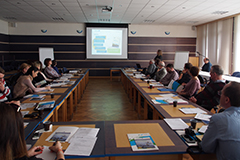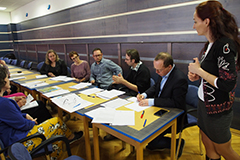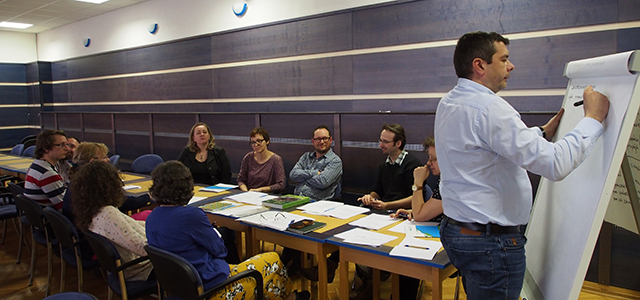Over 20 Slovak key stakeholders from the Tisza River basin came together to discuss significant water pressures and stakeholder involvement at the Slovak national consultation dialogue, which was held in the framework of the JOINTISZA project. Jointly organised by GWP Central and Eastern Europe, the Water Research Institute in Slovakia and Water Management Enterprise the dialogue brought together representatives of governmental organisations in the water and forestry sectors, the Ministry of Environment, ecological organisations, research institutes, NGOs and academia.
The workshop was opened by Richard Muller, Regional Coordinator of GWP Central and Eastern Europe, who outlined the challenges encountered in the Tisza River basin and stressed the importance of stakeholder involvement. Katarina Farbiakova from the Slovak Water Management Enterprise gave a detailed overview of the Tisza River, providing detailed information about its tributaries on the territory of Slovakia.
 Ivana Bajkovicova from the Water Research Institute presented the goals of the project JOINTISZA and the latest developments within its implementation. Following her presentation, Radoslav Bujnovsky (Water Research Institute) made a summary of the current ITRBMP, focusing on all the relevant issues for the Slovak stakeholders. The presentations were followed by an overview of the results from the Tisza-basin questionnaire concerning the Slovak participation were presented to all the participants.
Ivana Bajkovicova from the Water Research Institute presented the goals of the project JOINTISZA and the latest developments within its implementation. Following her presentation, Radoslav Bujnovsky (Water Research Institute) made a summary of the current ITRBMP, focusing on all the relevant issues for the Slovak stakeholders. The presentations were followed by an overview of the results from the Tisza-basin questionnaire concerning the Slovak participation were presented to all the participants.
The second part of the dialogue was led in World Café style, during which all stakeholders formed round tables where they discussed in groups previously identified issues. In facilitated discussions, the stakeholders debated on the existing plan, pointing out issues that need improvement and suggesting concrete improvements. Important point in the round tables were the issues of transboundary relevance that are important from stakeholders’ point of view and which should be targeted by the Updated ITRBMP.
Stakeholders provided comments to the identification of the pressures in 1st ITRBMP, as well as preliminary suggestions for the proposal of measures and preparation of the Updated ITRBMP. Some of the recommendations were to include more specific impacts and measures with regard to the different sectors. Also, climate change impacts, drought management, invasion species, river continuity should be considered, as well as to improve the cross sectoral cooperation and data exchange.
as well as preliminary suggestions for the proposal of measures and preparation of the Updated ITRBMP. Some of the recommendations were to include more specific impacts and measures with regard to the different sectors. Also, climate change impacts, drought management, invasion species, river continuity should be considered, as well as to improve the cross sectoral cooperation and data exchange.
A very important point for discussions at the round tables was how stakeholders see their role and contribution to the implementation of the Updated ITRBMP. The stakeholders commented that it would be useful to know how stakeholders in other countries participate in the planning process. Another issue was that there is need to encourage the active participation of certain sectors like industry, agriculture, municipalities, state administration and others.
JOINTISZA Project focuses on interactions of two key aspects, the river basin management (RBM) and flood protection, taking into account the relevant stakeholders who have pivotal role in the Tisza RBM planning process. The main aim of the project is to further improve the integration of the water management and flood risk prevention planning and actions in the next RBM planning cycle, in line with the relevant EU legislations.
The project will ensure better embedding of flood risk management planning into the RBM planning process and will also encourage the involvement of relevant sectors (such as flood risk management, water resource management, urban hydrology management, drought management) and interested stakeholders.
Agenda of the workshop (in Slovak).
Photos from the Slovak national stakeholder consultation in Kosice, Slovakia.

